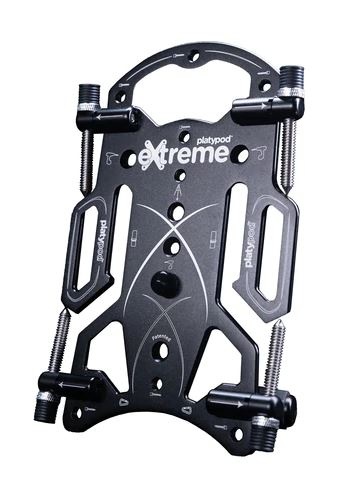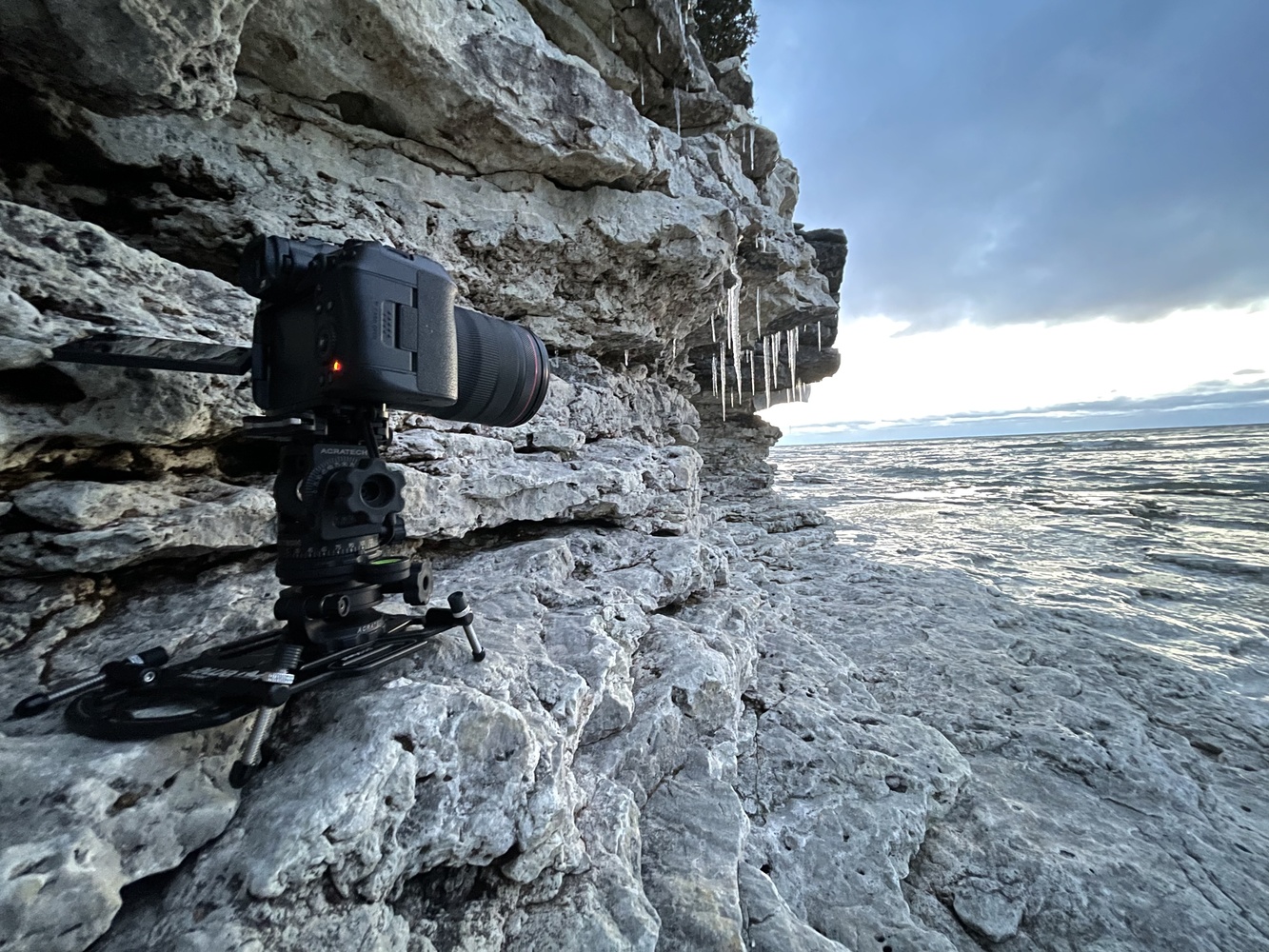Ok — let’s start with a disclaimer: I’m a fan of Platypod (both the company itself and the products individually). The most compelling photographs show us the world in a way we’re not used to seeing, which is where the Platypod excels.
Getting my camera away from eye level and onto the ground has fundamentally changed the way I shoot landscape and travel photos. This being the case, I was excited when first contacted about writing a review for their new device, the Platypod eXtreme. That said, I quickly struggled with wondering how they could improve on previous models and whether upgrading would be worth the cost. I was already pretty satisfied with my Platypod Max. Would a new version add any extra utility?

For background, Platypod originated with the goal of creating a lighter, smaller footprint for camera stabilization. It’s essentially a flat piece of metal with the ability to screw in a ballhead — simple, yet effective. Yes, you certainly could re-create this at home in a variety of ways. I suppose you could take a block of wood or a piece of metal from the hardware store and put a tripod screw in it. Or you could use a beanbag. Or you could just put your camera on the ground. These novel workarounds are compiled from the comments to my initial review article about the Max version, but none of them are as elegant as their precision-milled aluminum. While a piece of plywood is certainly cheaper (though maybe not much right now with current lumber prices), I care more about durability, weight, and protection for gear that might be worth $6-8k depending on my camera and lens configuration. In short, I want the best.
Building on previous versions, the eXtreme is like a refined multi-tool. Whereas earlier versions of those gadgets sacrificed every individual thing at the expense of being one tool for everything, the new models just do everything well. Similarly, the latest Platypod allows so many unique uses without any sacrifices. It's one of those things where you can judge the impeccable build quality just by holding it in your hands.

New Mechanism for the Spiked Feet
I think the most notable improvement is the attention paid to the spiked feet, which are pointed on one end and rubber on the other. The feet were always included so you could use it on unleveled terrain, but I always considered them an afterthought because I never had the patience to fiddle around with screwing them in (especially in cold weather). In fact, the only time I ever paid attention to the spikes was with regard to not losing them somewhere (ironic because I didn’t value them anyway). Unless the ground was fairly flat, I would just compromise by using my tripod at the lowest setting instead. The eXtreme eliminates this problem entirely with a unique lock and twist mechanism for the spikes. The advantage is that they’re always in place and usable without being in the way or prone to falling out. What was once an annoyance has become a strength. They give you complete and easy customization to establish a stable base anywhere you travel. I tested this on the porous rocky shores of Lake Michigan. In one instance, I placed the device on the side of a small cliff and had complete confidence in its holding power.  Even with gloves on, it was easy to adjust the spikes to keep my gear safe. Later on, I set the rig down on the shore to do some long exposures. It was fairly flat but I still put the spikes down for the sake of testing it out thoroughly. I felt very fortunate a few min later when an uncharacteristically strong wave came ashore and over the Platypod base. Thankfully it wasn’t high enough to damage my camera, but it certainly would’ve washed it somewhere else without the spikes. The biggest surprise was seeing my 2 minute long exposure still look perfectly sharp even after that wave. Frankly, I’m astonished at how stable it kept everything and can’t understate how much this new mechanism increases the utility.
Even with gloves on, it was easy to adjust the spikes to keep my gear safe. Later on, I set the rig down on the shore to do some long exposures. It was fairly flat but I still put the spikes down for the sake of testing it out thoroughly. I felt very fortunate a few min later when an uncharacteristically strong wave came ashore and over the Platypod base. Thankfully it wasn’t high enough to damage my camera, but it certainly would’ve washed it somewhere else without the spikes. The biggest surprise was seeing my 2 minute long exposure still look perfectly sharp even after that wave. Frankly, I’m astonished at how stable it kept everything and can’t understate how much this new mechanism increases the utility.
In addition to the new spike mechanism, other improvements are more of an evolution. I really like how much material they’ve been able to remove without sacrificing stability. It feels lighter in the hand (75% of the weight of the Max), and provides an abundance of attachment points. Whereas I carry my Platypod Max in a flat area of my camera bag, the openings made it easy to attach the eXtreme to my backpack with a carabiner and ballhead already attached to the plate. On a freezing day near Lake Michigan, it was much nicer to unclip the carabiner and start shooting immediately than it would’ve been to dig through my pack and put everything together in the dark.
Versatility
In addition, they’ve been able to increase the amount of attachment points for novel uses. While one could use it to attach a camera in an unusual location, I don’t find much of a need for that. However, I find it quite useful as a light stand for my flashes. It’s much more portable and easier than a dedicated light stand in some environments, like wrapping it around a column or putting a light in an obscure location. In this instance, I attached a speedlight to a column to take some fun lifestyle photos.
Here, I wanted to test whether it would hold larger gear. I attached a Magmod MagBox Pro 36" Strip and balanced it on our kitchen counter for an impromptu studio for some portraits of our kids. While this is something I would much rather shoot in a studio, I wanted to see whether this could be a novel option for someone on location, like a wedding photographer.


Although I was really impressed with the new unit, I found one very small aspect that could be improved although there is a good explanation for its design. While the 3/8” ballhead screw is embedded, there is a 1/4”-20 screw that is not. I was experimenting with using it as a base for my Insta360 ONE X2 and monopod and the 1/4”-20 screw came out with the monopod when I removed it from the eXtreme. While not a dealbreaker, I would need pliers to remove the screw from the monopod. I reached out to Platypod and not embedding it was an intentional decision out of concern that it could get in the way of larger panning ballheads, which is understandable. I think this could be remedied with a small amount of Loctite if having that size screw is important to you.
What I Liked
- Big improvement overall from the Max but the same build quality and stability with less weight.
- The spike feet went from an afterthought to a strength. The mechanism is impeccably designed, easy to use, and solid. They completely change the experience. They even designed it so the spikes can tuck into a groove in the metal to avoid them catching on anything when not in use.
- The attachment points expand the possibilities. It's so easy to put it anywhere you want, whether on your bag via a carabiner or on/around/inside/underneath almost any structure
What I Didn't Like
- It's a really small thing, but I'd like to see a better solution for securing the 1/4"-20 screw, although I think it can probably be remedied with minimal effort if that is important to you.
Conclusion
Overall, I was surprisingly impressed with the eXtreme. Because the Max has suited my needs so well, my own question was whether I would find it to be a valuable upgrade. In short, I absolutely think it is. The lock and twist mechanism of the leveling spikes improves the experience immensely with regard to stability in almost any environment. While some scoff at the idea of paying for such a simple device, I find it to be an unquestionably valuable tool and placed an order on Kickstarter the first day without any reservations.
Disclaimer: Platypod has a great track record of releasing products through Kickstarter, but you should always do your own research into any crowdfunding project, as there’s always the possibility that you can lose your money when backing this type of venture.











This is really a great upgrade at a glance. I always would scoff at platypod in the past as it always struck me as just a chunk of metal with a couple of holes in it that they charge an extremely high price for. (aka felt scammer to me)
This new one though feels like a genuinely innovative and useful design that introduces features that users couldn't just clone themselves in 5min with some metal, a drill, and a tap kit.
Couldn't agree more--it really adds a lot of utility and the mechanism was very well thought out